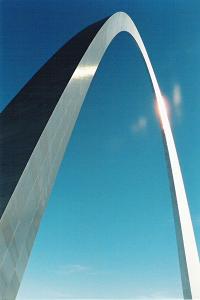Catenary
|
|
Catenary.png
In mathematics, the catenary is the shape of a hanging flexible chain or cable when supported at its ends and acted upon by a uniform gravitational force (its own weight). The chain is almost vertical near the points of suspension because this part of the chain has the most weight pulling down on it. Toward the bottom, the slope of the chain decreases because the chain is supporting less and less weight.
The word catenary is derived from the Latin word for "chain." The curve is also called the alysoid, funicular, and chainette. Galileo claimed that the curve of a chain hanging under gravity would be a parabola, but this was disproved by Jungius in 1669. In 1691, Leibniz, Christiaan Huygens, and Johann Bernoulli derived the equation in response to a challenge by Jakob Bernoulli. Huygens first used the term 'catenary' in a letter to Leibniz in 1690, and David Gregory wrote a treatise on the catenary in 1690.
If you roll a parabola along a straight line, its focus traces out a catenary (see roulette). As proved by Euler in 1744, the catenary is also the curve which, when rotated about the x axis, gives the surface of minimum surface area (the catenoid) for the given bounding circle. Square wheels can roll perfectly smoothly if the road has evenly spaced bumps in the shape of a series of inverted catenary curves.
The intrinsic equation of the shape of the catenary is given by the hyperbolic function
- <math>y = a \cdot \cosh \left ({x \over a} \right ).<math>
The inverted catenary arch
The catenary is the ideal form for an arch which supports only itself. If made of individual elements whose contacting surfaces are perpendicular to the curve of the arch, no significant shear forces will be present at the joints, and the thrust into the ground will be directly along the line of the arch.
The Gateway Arch follows the form of an inverted catenary. It is 630 feet wide at the base and 630 feet tall. The exact formula
- <math>y = 68.8 \cdot \cosh({0.01x - 1})<math>
is displayed inside the arch.
In structural engineering a catenary shell is a structural form, usually made of concrete, that follows a catenary curve. The profile for the shell is obtained by using flexible material subjected to gravity, converting it into a rigid formwork for pouring the concrete and then using it as required, usually in an inverted manner.
A kiln, a kind of oven for firing pottery, may be made from firebricks with a body in the shape of a catenary arch, usually nearly as wide as it is high, with the ends closed off with a permanent wall in the back and a temporary wall in the front. The bricks (mortared with fireclay) are stacked upon a temporary form in the shape of an inverted catenary, which is removed upon completion. The form is designed with a simple length of light chain, whose shape is traced onto an end panel of the form, which is inverted for assembly. A particular advantage of this shape is that it does not tend to dismantle itself over repeated heating and cooling cycles — most other forms such as the vertical cylinder must be held together with steel bands.
The Catalan architect Antoni Gaudí made extensive use of catenary shapes in his Sagrada Familia.
Other uses of the term
- In railway engineering, a catenary structure consists of overhead lines or cables used to deliver electricity to a railway locomotive, multiple unit, railcar, tram or trolleybus through a pantograph or sometimes a trolleypole. An alternative system is a third rail.
- In semi-rigid airships, a catenary curtain is a fabric and cable internal structure used to distribute the weight of the gondola across a large area of the ship's envelope.de:Katenoide

